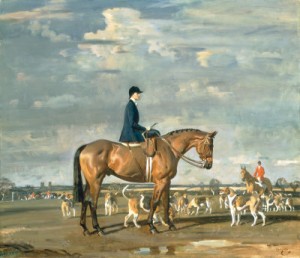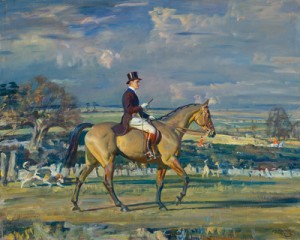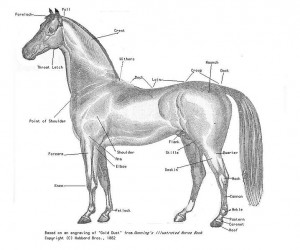Proportion and power for Thursday Art day – Sir Alfred James Munnings. 1878 – 1959
Sybil Harker on Saxa with the Norwich Staghounds
Sally Mitchell states in her Dictionary of Equestrian Artists that with Stubbs, Munnings is one of two great masters of sporting art. Born at Mendham, Suffolk of a farming family, his father, John Munnings was a miller. Alfred was apprenticed to Norwich Lithographs for six years, 1893 to 1898, and studied at Norwich Art School in the evenings. He later studied at Julian’s in Paris. He first exhibited at the Royal Academy in 1898 and in the same year lost his sight in one eye.
Lord Astor’s High Stakes
During this period he hunted regularly with the Norwich Stag Hounds and the Dunston Harriers. He spent some time in Cornwall with the Newlyn School and then moved to Dedham, Essex in 1918. He married twice and frequently used his first wife as a model.
My wife, my horse and myself
The Canadian Government commissioned Munnings as an official War Artist while he was attached to the Canadian Cavalry Regiment in France 1917-18.
Munnings mainly worked in oils but also in watercolours and he would make pencil sketches on any scrape of paper available. He also wrote humorous verse. He painted very fine pictures of gypsies with their horses.
Going out at Epsom 1929
Many prints were published after his work especially portraits of racehorses, signed copies of which now fetch quite high prices. Unfortunately a large number of faked watercolour sketches have flooded on to the market in the last few years.
Paul Mellon on Dublin
From my personal point of view I love the proportions of his horses which have me revisiting my pet topic the importance of balance and proportion in the structure of a horse. I especially love the power and precision of ‘Going out at Epson’.
From Wikipedia, https://en.wikipedia.org I have the opening paragraph on Equine Conformation and I have also included a drawing of the points of the horse.
You can read more about horse conformation at https://en.wikipedia.org/wiki/Equine_conformation
Equine conformation evaluates the degree of correctness of a horse’s bone structure, musculature, and its body proportions in relation to each other. Undesirable conformation can limit the ability to perform a specific task. Although there are several universal “faults,” a horse’s conformation is usually judged by what its intended use may be. Thus “form to function” is one of the first set of traits considered in judging conformation. A horse with poor form for a Grand Prix show jumper could have excellent conformation for a World Champion cutting horse, or to be a champion draft horse. Every horse has good and bad points of its conformation and many horses (including Olympic calibre horses) excel even with conformation faults.
Dessin cheval grand –Original image came from Manning’s Illustrated Horse Book by J. Russell Manning copyrighted by the Hubbard Brothers in 1882 and published by the Edgewood Publishing Company (located Riverton, NJ). User:Patrick Edwin Moran added the English text indicating body parts, etc.
Read the first Chapters of ‘Tails Carried High’ here :http://www.carmelrowley.com.au/features.html
Buy online here: http://www.carmelrowley.com.au/buyonline.html
Help spread the rumour here: http://www.carmelrowley.com.au/spreadtherumour.html
Like my Reading, Writing and Arabians page on Facebook:






Leave a Reply